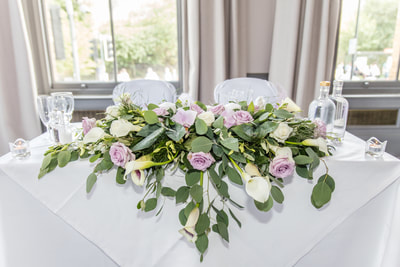|
As the title suggests I became a florist quite by accident. After 13 years as a teacher, I decided to have a hobby and go to night-school. I quite fancied graduating from cutting the cellophane off supermarket flowers and popping them in a vase (I also like gardening), so I chose floristry. What I found was that it was a bit like learning magic when you didn’t realise that magic existed! A world of colours and textures, add a bit of this to a bit of that and boom, something beautiful appears! It was a pleasing surprise when Ella asked me to write a piece for her blog, as I still ask myself ‘does this look as if a florist made it?’ when I finish an order. I’m still learning the trade, but after 2 years and 100's of hours working with flowers, I do have some insight to share. An average wedding will see me spending 10 hours resourcing, sourcing and messaging; 3 hours at the wholesalers; 3 hours travelling to the venue and setting up; 3 hours preparing and soaking the flower and then anything from 10 - 30 hours actually arranging the wedding flowers. So here are my top tips. 1. Remember that ‘A picture paints a thousand words’ You may not know a daffodil from a dahlia from a dianthus, but your florist will. As you approach planning your wedding flowers, send your florist a picture of what you like and it should be everything that they need to know. Once I’ve seen what a bride likes, I can make suggestions (such as excellent seasonal flowers or other flowers that will work well) or simply make an identical bouquet. 2. Trust the expert Flowers are expensive - we are not driving in a Rolls Royce or buying designer hand bags. It’s just the cost of a beautiful, high quality product. Flowers from the wholesale Dutch market or even tea roses from Colombia, are a premium product and worth every penny. That said, we can tailor our choices to suit your budget (If you want to give me £100 and send me to the local supermarket I’m happy to do that). But first, we can try some cost saving measures such as smaller, leafier arrangements or just choosing cheaper flower options. 3. A good florist (in my opinion) should start with your wish list. If it all adds up and you're happy, then go for it! If it doesn’t and you are still unsure, then don’t be afraid to ask about cost saving measures that will help you stick to a budget. Do be realistic though- there are 40-50 stems in a bridal bouquet and some flowers can be £3 a stem. 4. Research If you want to follow fashion and current trends, then the magazines are full of inspiration. From blush pink flowers, rose gold accessories, to horizontal/ oversized bouquets, even the classic cascade made famous by Princess Diana, has made a resurgence too. Personally, I’d say choose something that you love. Roses are always stunning and if you choose a neutral colour (cream, or pale pink) they tend to go with most colour schemes. Flowers are not necessary for a wedding day, but they do enhance your experience. They add to the décor, the sense of occasion. They heighten the atmosphere and lend an air of romance too. There will always be family members or friends who would be thrilled to be gifted a centrepiece or posy. They needn’t be ‘just for a day’, so why not use them as thank you gifts for those who have helped out (I remember the endless list of gifts from my own wedding). We want to thank those who help out, so why not have a dual purpose item? If budget is no barrier then the sky’s the limit. Pedestals, arches, runners, even whole walls of flowers can be made. Just indulge yourself on your special day. www.myfloralisa.co.uk [email protected]
0 Comments
Leave a Reply. |









 RSS Feed
RSS Feed